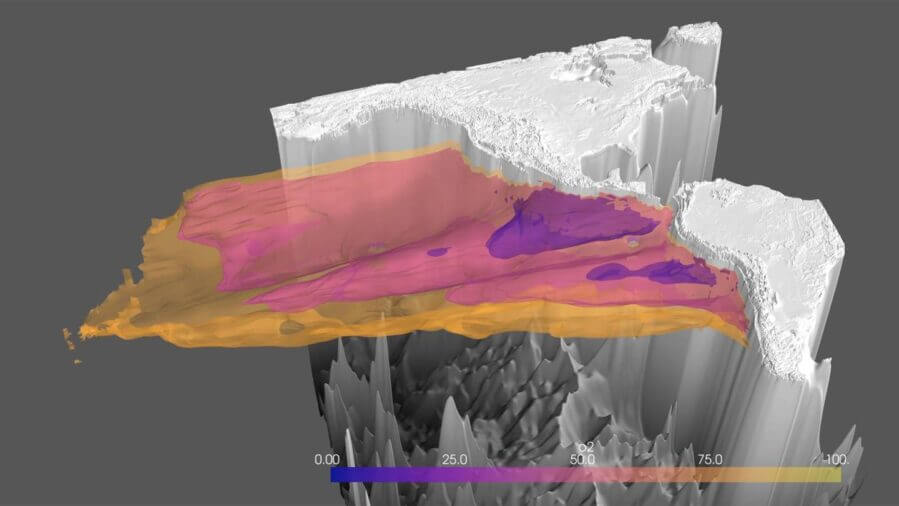Areas of low-oxygen water stretch for thousands of miles through the world’s oceans. The largest of these “oxygen minimum zones” (OMZs) is found along the Pacific coast of North and South America, centered off the coast of Mexico.
Until recently, climate models have been unable to say whether OMZs will grow or shrink from climate change, in part because OMZs result from two opposing processes: oxygen supplied by ocean circulation and oxygen used by sea life.
Now, a team led by Princeton’s Laure Resplandy has confidently predicted that the boundaries of the Pacific OMZ, the planet’s largest, will expand by as much as 2 million additional cubic miles (8 million cubic kilometers) — both upward toward the sea surface and outward toward the coast — by the end of the century.
This is significant for two reasons, said Resplandy, a biogeochemical oceanographer and an assistant professor of geosciences and the High Meadows Environmental Institute at Princeton. For one, as oxygen levels go down, vital economic species like tuna and crabs won’t be able to feed, swim or reproduce unless they relocate to ocean regions with more oxygen. This has major implications for ecosystems near the ocean’s coasts and the industries that depend on them, from fishing to tourism. Second, OMZs are a significant source of nitrous oxide, a major greenhouse gas.
Her team’s successful projections are not just due to new and better models, though they are using the latest suite, the Coupled Model Intercomparison Project 6 (CMIP6). The key insight, Resplandy said, was understanding that the OMZ isn’t uniform but has layers “like an onion” that respond differently to rising greenhouse gases.
Fundamentally, OMZs are made up of an outer layer and an inner core, and the new models show that the core will shrink while the outer layer will expand.
In prior work, OMZ changes were assessed using the intermediate layers, between the expanding outer layer and contracting core, where only small shifts were found — sometimes positive, sometimes negative. “The changes were near zero, and different models showed contradicting trends, some leading to an expansion and others to a contraction of the OMZ. It looked like a discrepancy,” said Julius Busecke, who led the research while a postdoctoral research fellow at Princeton and who is now a physical oceanographer at Columbia University.
“We had thought climate models were inconsistent, with trends all over the place,” Resplandy said. “But we now know that we were asking the wrong question — asking whether we should expect an expansion or contraction instead of considering that it might be both.
“We started having a more holistic approach and looking at the evolution of those different onion peel layers, the outer one being most important for ecosystems and the core being important for nitrous oxide production,” she said. “That’s when we found that the models were not actually in disagreement. They agreed that the outer layer would expand and be a problem for ecosystems, but the core would contract, potentially producing less nitrous oxide.”
Their new layered framework resolved years of frustration. “For 15 years, we’ve been circling around the same conundrum: With global warming, the ocean is losing oxygen, so we expect oxygen minimum zones to expand, but our climate models showed inconsistent trends,” Resplandy said. “In our papers, climate modelers wrote, ‘The model trends are inconsistent, so we don’t know what the impact on ecosystems and nitrous oxide will be.’ I was tired of writing these sentences. I was tired of reading them. When I came to Princeton five years ago, I told myself, ‘OK, we need to solve this problem.’ It was an obsession of mine.”
Coming up with the layered framework was “a lot of work, but I’m very happy that we finally make sense of future OMZ projections,” she said.
Her team’s models show that if high greenhouse gas emissions continue, the tropical Pacific OMZ will grow 6 to 8 million cubic kilometers — about 1.4 to 2 billion cubic miles, or about 0.6% of the volume of the world’s oceans — by 2100. Over much of its area, it will likely expand toward the surface by 5 to 50 meters (16 to 160 feet).
Conversely, the new models show that as the outer layer expands, the OMZ’s core, where the oxygen levels are lowest, will contract.
That’s a small upside. The OMZ core produces nitrous oxide, so shrinking may limit how much of this greenhouse gas is released into the atmosphere. “I think not having that core region balloon out is probably good news,” Busecke said.
Coincidentally, paleo-oceanographers in Danny Sigman’s lab at Princeton discovered earlier this year that low-oxygen zones led to reduced nitrous oxide production during warm periods 15 to 50 million years ago. They had used tiny extinct creatures to calculate what oxygen and nitrogen levels had been.
“It’s very interesting to see the paleo-oceanography results,” Busecke said. “They’re completely independent of our climate models, and they support our findings that the OMZ core might be shrinking in the future despite warming. This gives us confidence that we are on the right track and can move forward.”
“Diverging fates of the Pacific Oxygen minimum zone and its core in a warming world“ by Julius J.M. Busecke, Laure Resplandy, Sam J. Ditkovsky and Jasmin G. John was published Nov. 23 in the journal AGU Advances (DOI: 10.1029/2021AV000470). This study was supported by the Cooperative Institute for Modeling the Earth System between NOAA’s Geophysical Fluid Dynamics Laboratoryand Princeton University, the High Meadows Environmental Institute CMI, the Sloan Foundation, and L.R. NSF CAREER Award Number 2042672 and the Gordon and Betty Moore Foundation (Grant 8434).


